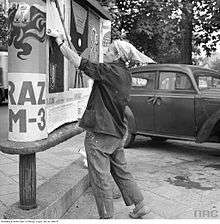Polish School of Posters
Beginning in the 1950s and through the 1980s, the Polish School of Posters combined the aesthetics of painting with the succinctness and simple metaphor of the poster. It developed characteristics such as painterly gesture, linear quality, and vibrant colors, as well as a sense of individual personality, humor, and fantasy. It was in this way that the Polish poster was able to make the distinction between designer and artist less apparent.[1]

.jpg)
Posters of the Polish Poster School significantly influenced the international development of graphic design in poster art. Their major contribution is in their use of the power of suggestion through clever allusions. Using strong and vivid colors from folk art, they combine printed slogans, often hand-lettered, with popular symbols, to create a concise inventive metaphor. As a hybrid of words and images, these posters created a certain aesthetic tension.
In addition to aesthetic aspects, these posters were able to reveal the artist's emotional involvement with the subject. They did not solely exist as an objective presentation, rather they were also the artist's interpretation and commentary on the subject and on society.
Artists
- Roman Cieślewicz
- Wojciech Fangor
- Mieczyslaw Gorowski
- Tadeusz Jodlowski
- Jan Lenica
- Bogusław Lustyk
- Jan Młodożeniec
- Józef Mroszczak
- Franciszek Starowieyski
- Waldemar Świerzy
- Henryk Tomaszewski
- Maciej Urbaniec
- Mieczyslaw Wasilewski
- Jan Sawka
- Jerzy Napieracz
Historic collections
The largest and most complete private collection of Polish posters, dating from 1909 to the modern era, is the Rosenberg Poster Collection (rosenbergcollection.com). The posters show a unique story of creativity under oppression. The courageous artists brought color, message and beauty to the streets as the war-torn cities were re-built and posters were displayed in street kiosks, on building walls and fences.
The largest state-owned collection of Polish posters is the Poster Museum at Wilanów. It is the world's oldest poster museum, founded in 1968, housed at the Wilanów Palace complex in Warsaw.
Sources
- Praca Zbiorowa: Encyklopedia sztuki polskiej, hasło "plakat". Kraków: Wydawnictwo Ryszard Kluszczyński, 2002, s. 500–501. ISBN 8388080563.
- Praca Zbiorowa: Polska Szkoła Plakatu w latach 1956–1965. Warszawa: Muzeum Plakatu w Wilanowie, Oddz. Muzeum Narodowego w Warszawie, 1988.
- Elizabeth E. Guffey: Posters: A Global History. Reaktion Books, 2014. ISBN 9781780234113.
- Joseph Czestochowski: Contemporary Polish Posters in Full Color, Dover Publications (June 1, 1979)
- Jacek Mrowczyk: VeryGraphic. Polish Designets of the 20th Century, Culture PL (February 23, 2016)
- Kempa, Karolina (2018), Polnische Kulturplakate im Sozialismus. Eine kunstsoziologische Untersuchung zur (Be-)Deutung des Werkes von Jan Lenica und Franciszek Starowieyski, Wiesbaden: Springer, ISBN 978-3658188542
References
- Contemporary Polish Posters in Full Color, Dover Publications, Inc, New York, NY., 1979
External links
- The Origins of the Polish School of Posters
- 6 Legends of the Polish Poster School
- http://culture.pl/en/article/18-most-important-polish-graphic-designers-of-the-20th-century